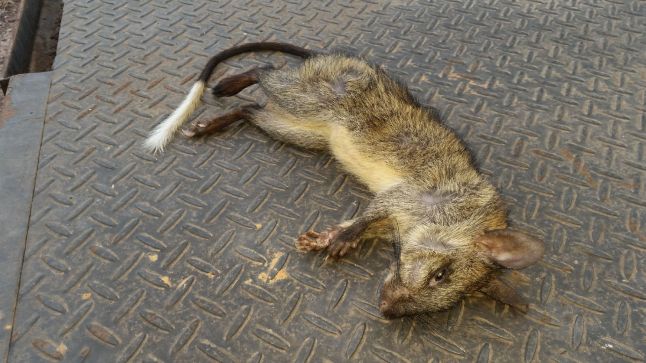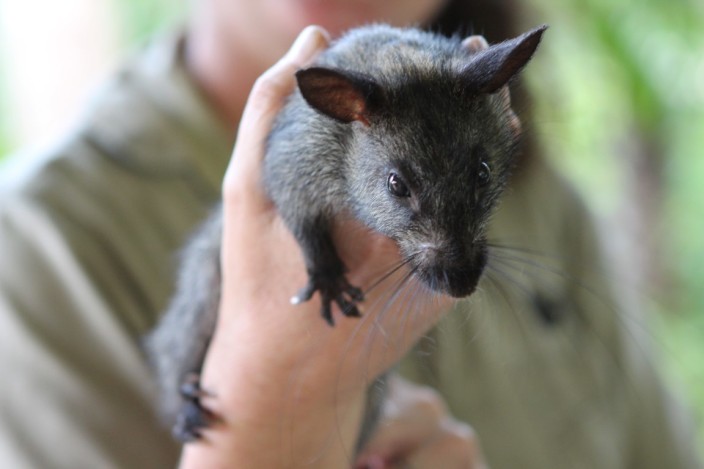WHAT RAT IS THAT?
The Black-footed Tree-rat is a large native rodent with a body 250 – 310 mm and tail 320 – 410 mm long, and weighing 650 – 880 g. It has distinctive markings: the pelage is grey, with much longer black hairs on its back and rump. The ears are very long and black, and the feet and legs are black. The tail is also black and very long, with the last quarter covered in longer pure white hairs.

The Black-footed Tree-rat is found across northern Australia, and is found in the Top End of the Northern Territory in open woodlands, riverine areas and along the coast.
Populations have declined an estimated 30– 50% in the last 10 years. It is listed as endangered Australia wide (and vulnerable on an NT level)
These rats (BFTRs) seem to be doing well in the Darwin and rural region, but are in deep decline further out. This may be due to access to more water, food sources and hiding places nearer where people are living and an increase in hotter fires and predators further out.
Black-footed Tree-rats are nocturnal, frugivores (eating mainly fruit) and shelter and nest in tree hollows.
DON”T KILL RANDOM RATS!– The photograph below is a Black- footed Tree-rat (Mesembriomys gouldii). A dead one, accidentally killed by a resident in Howard Springs who mistook it for a Rattus rattus (our common introduced pest rat).

Please pass on the message that before killing rats that you are think are pests- make sure that they are not our natives!
Rat-sack, snap traps and other methods do not discriminate! If you are unsure if you have natives then you can live trap and then re-release if they are.
Keeping pets (in particular dogs and cats) under control and not allowed out at night when these nocturnal animals are out and about eating fruit.
This is a juvenile rat (pictured above), but generally they are larger than our pest rat, with darker ears and black feet and their tail looks like it is dipped in white paint.
These gorgeous creatures are endangered and although seemingly common in the Darwin and rural area they are declining greatly in numbers elsewhere- so let’s look after them!
ENHANCE THEIR HABITAT (like in our member’s program) is always helpful- plan some more of their favorite native fruit trees, and install nest boxes. In addition to try and retain, or begin to grow old growth trees that can harbor hollows by keeping any uncontrolled and hot fires out of your property and further landscapes.

REPORT IF YOU SEE THEM–
Many members and people in the rural area say they often see the Black-footed Tree-rat or that they live in an old car or roof.
If you can positively identify these fantastic rats and have seen them recently- then let everyone know. They are endangered and a lot less common further away from Darwin and the rural area. The more data on them the better.
Similarly any other species of native fauna, such as echidnas, sugar gliders and phascogales can be recorded.
You can upload your sightings of any native fauna species to the NT’s Wildwatch. Your sightings will be recorded in official records and be able to be viewed by others via NR Maps. Check out www.wildwatch.nt.org.au
If you are in our nest box program and the species are in the nest box we will be submitting this information for you.
